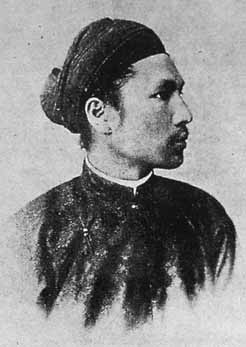 | New Page Title |
| The Siege of Ba-Dinh | |||||||||||||||||||||
Father Tran Luc and The French Victory
Ba-Dinh was the name of a village fortress in the Thanh Hoa province where at the end of the 19th century Vietnamese resistance fighters under the command of Dinh Cong Trang had withstood attacks by the French colonial forces for several months. It could be said that the history of Ba-Dinh began in 1885 when Emperor Ham Nghi proclaimed the Can Vuong Edict calling all Vietnamese to take up arms to resist the French who had initiated their gradual conquest and colonization of Vietnam in 1858. Responding to this Edict, Confucian scholars and peasants in the Thanh Hoa province established at Ba-Dinh a fortress in order to fight the French."In essence this was a carefully planned, well executed position defense of three integrated villages, aided by the surrounding maze of swamps, mud flats, and high bamboo thickets. As such, it was bound to fail, given complete French superiority in artillery and naval gun fire. Still, there are aspects of this resistance which deserve more than passing mention. First, there was the precise, studied manner in which scholar-gentry from throughout the province - not just the local district - agreed on Ba-Dinh as the most defensible possition, selected a scholar-gentry commander-in-chief, and parceled out jobs to units in other villages. They then devoted several months directing the constructions of fortifications, for which they drew supplies and labor from villages many miles away. For example, each village in the districts of Nga-Son and Tong-Son contributed thirty large wicker baskets, one hundred bamboo poles, and ten shoulder-pole loads of straw. Thousands of peasants dug a moat around the entire complex and piled mud up to make a wall, using straw as the strengthening agent. Behind this, one or more shorter defense rings were constructed. The wicker baskets took the place of sandbags; they were filled with dirt and used in the construction of firing embrasures. Most of the bamboo poles formed multiple rings of spikes around the position, many of them under water." (1)
The man selected to be Ba-Dinh's commander-in-chief was Pham Banh, a mandarin who received his Cu Nhan degree in 1884. Being conscious of his military limitations Pham Banh had, however, delegated all tactical authority to Dinh Cong Trang, an experienced guerilla leader from outside Thanh Hoa. (2) "While skirmishes [at Ba-Dinh] occured from October 1886 onward, the French only moved in seriously on December 18. Several units did penetrate the outer defenses, but they were pinned down and isolated and their officers killed or wounded. Hastily withdrawals were finally executed under cover of 81 millimeter cannon fire. French forces then marked time while distant reinforcement were called on, building up by early January 1887 to some fifteen hundred French and one thousand native colonial troops, plus four gunboats and five thousand coolies recruited from the Catholic villages of Phat Diem." (3)
The Catholic labor force from Phat Diem stood under the leadership of Father Tran Luc. According to professor Nguyen The Anh, a recognized authority on Vietnam's modern history, Father Tran Luc was a zealous assistant to Bishop Puginier. He was most familiar to the French expeditionary corps under the name of P. Six and had always provided them with highly valued information. As professor Nguyen The Anh has put it himself: "Auxiliare zélé de l'evêque Puginier, ce dernier était plus connu du corps expéditionaire francais sous le nom de P. Six, et lui avait toujours fourni des renseignements très estimés." (4)
|
|||||||||||||||||||||
|
|
||||||||||||||||||||
|
|
||

